American Baseball is the national pastime of America. Being a fascinating game in the USA, people are also fascinated with the baseball field. But I bet everybody doesn’t entirely know about the details of a baseball field, especially the youth.
A baseball field overview could be a crunchy and happy read for people who love to learn new things.
The baseball field is also known as a diamond for its diamond-sized shape. Other names are also defined for a baseball field, such as ball field, baseball park, ballpark, etc.
Baseball is entertaining to watch if you understand the game’s fundamentals, including the baseball field. If you are just started playing baseball, it’s time to learn about the park.
Let’s have fun by exploring the baseball field layout, positions, dimensions, specifications, and a lot more.
Common Specifications of a Baseball Field
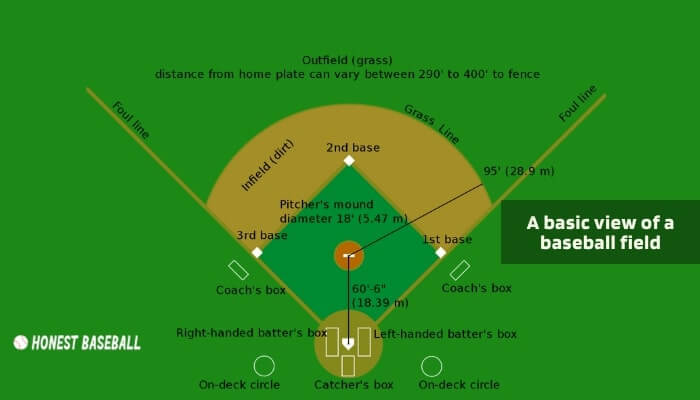
All ballparks are not exactly the same look alike.
But, according to the official baseball rulebook and the official site of MLB (Field Dimensions | Glossary | MLB.com, n.d.), there are some common specifications for a baseball field. This will give an insightful view of the field.
Here you got to go with the following table.
| Attributes | Specifications |
| Surface Material | Natural green grass |
| The Infield | Must be a square 90 feet opposite distance from each other bases must be the same level as the home plate |
| Outfield | It is the area between the two foul lines extending from the square toward all sides. |
| Home Plate to Fence Distance | To the right and left field foul lines, the distance must be a minimum of 325 feet between the nearest fence and the home plate. The minimum distance must be 400 feet between the home plate and the nearest center field fence. |
| Pitching Mound | The dimension of the pitching rubber is 24” x 6”. It is a white color slab placed 10 inches above the home plate. The pitching rubber is placed 18 inches behind the pitching mound’s center. The pitching mound diameter is 18 feet. Pitching mounds start decreasing to the slope by 1 inch on every foot toward the home plate. The decrease starts from 6 inches ahead of the pitching rubber. |
| Home Plate | It is a pentangle-shaped whitened rubber. One side is 17 inches, and the adjacent sides are 8.5” both. The two remaining sides are 12 inches each, which makes the gift corner of the pentangle. |
| Bases | 15 inches square, the whitened rubber material |
Here you got to go with some basic baseball field layout ideas visually:
Baseball Field Layout
A basic visualization of the baseball field layout would help dig into the deep. The first question that may come to mind is, what shape is a baseball field?
The shape of the baseball field is conoid. You will see the baseball field’s home base, first base, second base, and third base. Also, the infield and outfield are the two most important parts. The bases are formed inside the infield like a diamond shape.
You will see the foul lines of a baseball field beside the baselines. These are third to home base and home base to first base. The foul area is also known as foul territory. A square shape is created with lines of four bases.
The pitcher’s mound is Inside the square, from where the pitcher pitches the ball to the batter. A whitened pitching rubber is attached to the pitcher’s mound to support the pitcher’s body balance.
All of the mentioned components are located in the infield area. The infield is a part of the fair territory. The area between the bases is known as fair territory. The infield area is an artificial area that separates it from the outfield area of the baseball field.
For your information, the grassy area of the field behind the infield to the fence is called the outfield.
The distance between the home plate and the centerfield wall ranges between 290 feet and 400 feet, based on the league type and age group. Two separate foul poles on the two sides of the home plate marked the foul area.
The baseline and home plate area to the fences is marked as the fair territory of the baseball field.
These were all about the basic baseball field layout. We will explore the things elaborately in the later sections of the article on baseball field overview.
See Also: How Many Baseball Players on the Field? An In-Depth Analysis.
Home Plate Dimension

If we talk about baseball starting, then home plate is the game’s starting point. Also, a baserunner must complete a home run from home plate to the home plate via first – second – third base to get one run. Officially the home plate is called home base.
What shape is the home plate in a baseball field?
It’s a five-sided rubber slab. The shape could have been a rectangle, but not because the rectangular shape changed behind the two adjacent sides of the front side of the home plate.
When you measure the home plate size, you will find the front part is 17 inches. And the adjacent sides of the front side are 8.5 inches each. After that, the two sides took a break and connected at a length of 12 inches each.
The 12-inch lines at the back are triangular in shape. When this dimension is used, it provides an angle that results in a 45-degree point.
A 1.9 cm black rubber strip surrounds the home plate on the ground. The 17 inches rectangle with each 8.5 inches adjacent line is situated in the fair territory. The rear 12 inches lines are aligned with foul lines.
If want to dominate the home plate with the bat, you might check out some cool and best BBCOR baseball bats with the best features and prices.
Batter’s Box
You will see two batter boxes beside the home plate. Two batter boxes for right-handed and left-handed batters. The batters of the offensive team bat from the batter’s boxes.
Pitching Mound
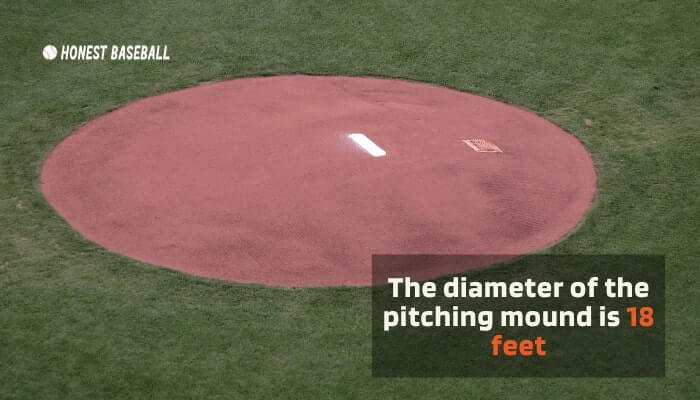
The Pitching mound is the persistent place for the pitcher who pitches the ball toward the batters. When you measure the distance between the pitcher’s mound and home base, you will find this 60 feet and 6 inches.
The pitching mound is equally far from first base and third base. Generally, the home base goes 10 inches downslope from the pitcher’s mound.
When you measure the diameter of the pitching mound, you will find it 18’. The pitcher’s rubber inside the pitching mound is 24 inches by 6 inches.
Pitchers benefit from increased pitching mound height because it provides them with additional grip and forward acceleration on the ball. This makes it more difficult for the batter to hit the ball in the given circumstance.
First Base
You will see the first base of the baseball field 90 feet away from the home plate, anticlockwise side. Bases are the points at which baserunners must make contact in order to advance to the home base to get 1 run.
The first baseman is typically tall and sluggish, and he is responsible for the defense of the base from the defensive team. The base bags are 15 inches square and 3 to 5 inches thick. They are made of soft materials.
Second Base
You will also find the second base in an anticlockwise way from the first base. This is also 90 feet away from the first base. The baserunner from the batting side must touch the second base to get 1 run.
Keystone corner and keystone sack are the two other names for the second base. The baserunner who touches a second base is in the scoring position because he is most likely to complete a home run from second base during the base hit.
The baserunner on the first base usually targets the second base for base stealing. He tries to reach the second base before the pitcher pitches the ball to the batter.
An infielder who defends the second base is called the second baseman. The second baseman should be a quick guy.
Because he needs to throw the balls after fielding as quickly as possible, Double-play chances are created based on his quick response. The second baseman wears jersey number 4.
Third Base
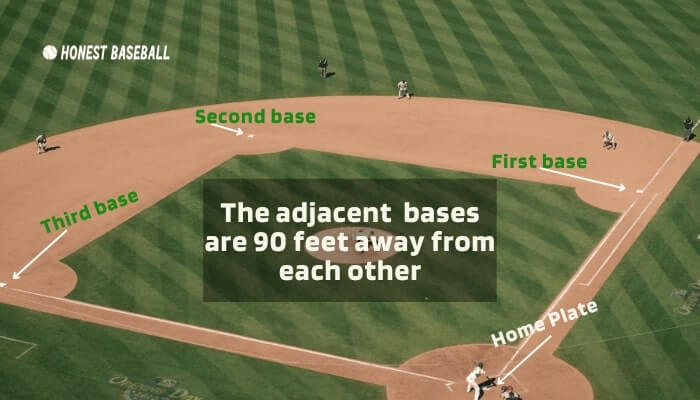
The closest base to get a home run is the third base. Because when the baserunner gets the third base, just another 90 feet distance remains to complete to get a run.
Even after the other two batters have been recorded out, a sacrifice fly allows the base runner from third base to finish the home run with one swing. After the baserunner completes the home run, the final or third out is posted on the scoreboard.
All base runs must be completed in an anticlockwise direction from the home plate to be valid, as I mentioned before.
The third baseman is responsible for field and defending the third base. In most cases, he must be a tall and strong guy. Because he has to throw the hit ball to first base for fielding purposes. And you know, the distance of the first base from the third base is 127 feet long.
Foul Lines
If you have a look at the baseball field overview, you will see the baseball field foul lines behind the home plate. The area is marked from third base to first base, through the home base.
The area between the foul line is called foul territory. The area is extended to the foul poles on two sides. The foul line is 320 long from home base.
If the hit ball falls into foul territory, it will be counted as a foul ball.
Foul Poles
Foul poles are yellow poles that are an important element of a baseball field’s infrastructure. When you look at the baseball field layout, you will see two yellow poles at the end of each foul line.
The foul poles are used to separate the foul area and fair territory. The umpire can make the decision of a hit ball if it falls behind the foul poles or not. A ball is fair when it hits the foul pole.
The foul pole is actually aligned with the fair line. Ultimately, you can say the foul pole is a “fair pole”. And if the ball travels over the fence or wall in the fair territory, it will be a home run.
Additional Read: How Many Acres Is A Baseball Field | All The Information You Need!
Catcher’s Box
The area behind the home plate where the catcher stands to catch the ball thrown by the pitcher. The catcher is from the defensive team.
Coach’s Box
You will see two coach boxes behind the first baseline and third baseline. Coaches have the option of remaining inside or outside the coach’s box. This holds true until they don’t interfere with the game or the opposing team objects.
Baseball Field Bunch
Baseball field positions come from the defensive team. You can divide the fielding position into three main categories.
- Baseball Battery: The battery is formed with two fielders: the pitcher and the catcher.
- Infielders: The infield fielding barrier is formed with four fielders in baseball. As I mentioned before, the basemen are part of the infield position. Also another shortstop is also included in the infield position. The shortstop plays between the second and third bases.
- Outfielders: You will see three fielders in the baseball field’s outfield. Right fielder, center fielder, and left fielder are the positions available.
Baseball Field Measurements
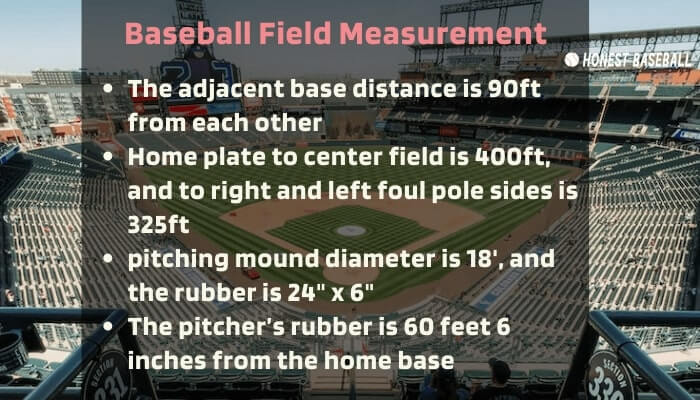
In general, baseball field measurement refers to the dimension of the field for Major League Baseball (MLB). Because you will see a variation of the dimension when looking up the baseball field overview. Baseball field dimensions change according to the age and league of baseball.
You will see the aged group field dimension in the later sections. The standard dimension for the MLB is as follows.
- The base distance is 90 feet long adjacently.
- The distance between the home plate and the fence through the centerfield is 400 feet or more.
- The minimum distance between the home plate and the nearest fence is 325 feet, mainly on the side of foul poles.
- The distance between the home plate and the foul pole is 320 feet.
- The pitching mound is 18 feet in diameter, and the pitching rubber is 24” x 6”.
- The pitcher’s rubber is 60 feet 6 inches from the home base.
- Opposition bases are 127 feet 3.375 inches away from each other.
How Is The Age Group Baseball Field Dimension Measured?
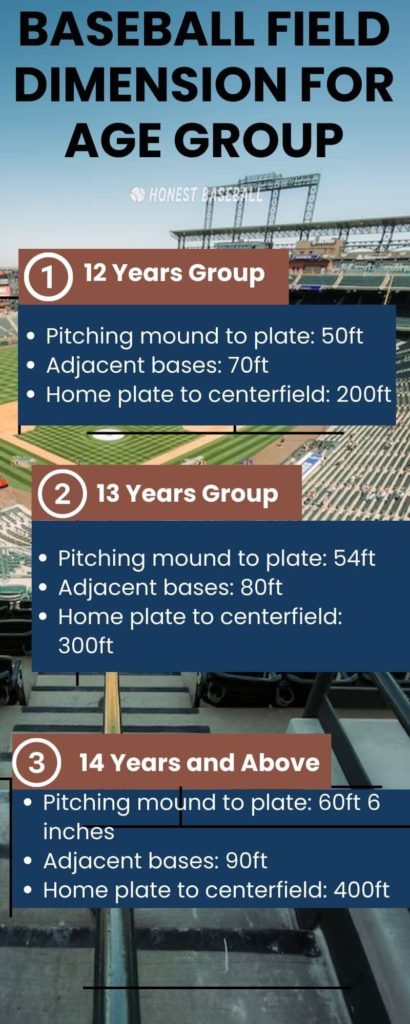
The following is the baseball field overview for the field dimension for the different age groups in baseball games.
- 12 Years Group: Plays on the field, which is 50/70. That means the pitching distance is 50 feet, and the distance between adjacent bases is 70 feet. The distance of the wall through the centerfield from the plate will be 200 feet.
- 13 Years Group: Plays on the field, which is 54/80. That means the pitching distance is 50 feet, and the distance between adjacent bases is 80 feet. The distance of the wall through the centerfield will be 300 feet.
- 14 Years Group: This group of kids almost reaches to play in a full-sized baseball field. They Play on the field, which is 60/90. This refers to the distance of the pitching rubber is 60 feet 6 inches.
And the distance of adjacent bases is 90 feet from each other. The distance of the wall through the centerfield will be 400 feet.
Softball Field Dimensions
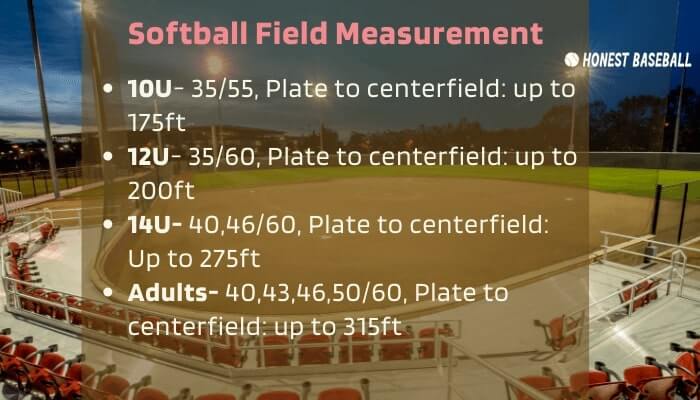
In softball, ball, and pitching distances are different from baseball. In baseball, MLB and other adult leagues are playing with a standard 60 feet 6 inches distance. On the other hand, the standard distance between the pitching rubber and the home base is 43 feet in softball.
The ball circumference is also different. Nine inches is baseball’s circumference, whereas softball’s circumference is 9 inches.
Following are the field dimensions for the 43/60 softball field.
- Girls & Boys- 10U: Play with 55 feet base distance and 35 feet pitching distance for both fastpitch and slowpitch. The home-to-centerfield distance ranges from 150 feet to 175 feet.
- Girls & Boys- 12U: Play with 60 feet base distance and 35 feet pitching distance for both fastpitch and 40 feet for slow pitch. The home-to-centerfield distance ranges from 175 feet to 200 feet.
- Girls & Boys- 14U: Play with 60 feet base distance and 40/46 feet pitching distance for fastpitch and 46 feet for slow pitch. The home-to-centerfield distance ranges from 175 feet to 275 feet.
- Girls & Boys- Adult: Play with 60 feet base distance and 40, 43, and 46 feet pitching distance for fastpitch and 50 feet for slow pitch. The home-to-centerfield distance is from 200 feet to 315 feet.
Synthetic Turf Baseball Field
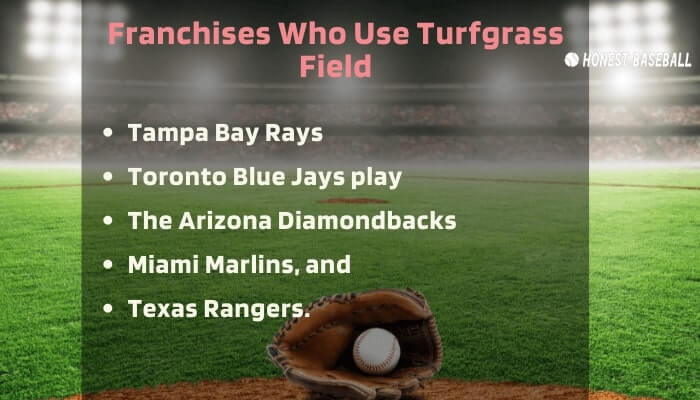
Figure 08- Franchises Who Use Turfgrass Field
As we mentioned, you must know, baseball fields are normally surfaced with natural grasses. But, all ballparks are not the same. It’s for both major league games and minor league baseball.
However, there are ballparks that are surfaced on the field with artificial turfgrass due to several reasons in recent years.
Since 1982, 20 of 26 MLB teams have been playing on turfgrass. But, the trend did not last at all. By the year 2018, two teams- Tampa Bay Rays and the Toronto Blue Jays were in the play of turfgrass.
By the way, over the 12 months of 2020, during the COVID-19 pandemic, three new MLB franchises joined the artificial baseball field renovations.
The baseball field renovations took place for different reasons like maintenance, injury prevention for the baseball players, etc.
One of the reasons to get into turfgrass for the field of the Arizona Diamondbacks is dessert. Being a desert area, the field gets dry, and the ball doesn’t play rightly and gets more rolling on the field.
Currently, the following 5 ballparks are playing on the turf surface in their home ground-
- Tampa Bay Rays
- Toronto Blue Jays play
- The Arizona Diamondbacks
- Miami Marlins, and
- Texas Rangers.
Frequently Asked Questions:
Who Created The Baseball Field Diamond?
Abner Doubleday invented and designed the baseball field diamond along with the word “baseball” in 1839 in New York.
Why Is a Baseball “Diamond” More Commonly Used Than a Baseball Field?
The bases are like the shape of a diamond in a baseball field. This is the reason behind the name ‘diamond”.
What Are Baseball Field Sizes Represented By Two Numbers?
The field size of the base with two numbers, for example, 60/90, refers to the pitching length and baseline length. It means the pitching distance is 60 feet 6 inches, and the base run distance from one base to another adjacent base is 90 feet.
How Many Players Are On A Baseball Field?
There are 9 players on each side of the baseball team. And all 9 fielders from the defensive side can field during the fielding.
Final Note on Baseball Field Overview
A detailed but short baseball field overview could help you understand a baseball field’s basic layout and dimensions.
As a new baseball player or a diehard fan, you would be cherished learning the baseball field basics in this guide.
Without knowledge of the baseball field, becoming a good player is tough. Because the knowledge base should be strong for analysis and playing games.
You May Also Like:
Baseball Statistics Explained for Beginners
What Is ERA In Baseball? | A Wide Explanation
How To Play Baseball | Everything You Need To Know
20 Best BBCOR Bats That Are Ready To Dominate The Plate In 2022
Top 3 Wilson Outfield Gloves | MLB Players’ Choice

Hello everyone. My name is Jason Butler, and I live in California, America. I was a professional AAA Minor League Baseball player. I lost my chance of playing MLB for injury issues, but I did not lose my love for baseball. I attended the coaching training program and am now working as a coach in a small school in San Diego.
I always love to share my experience and knowledge if that can help you. Play baseball, and stay fit.
